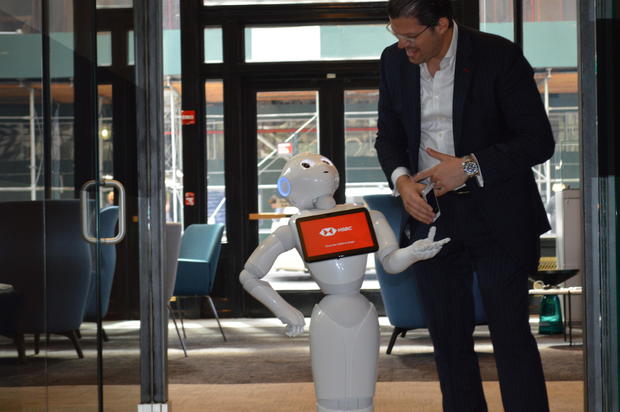HSBC's new bank customer assistant is a robot
Banks have used technology for back-office functions like check-clearing, record- keeping and regulatory compliance for decades. But as technology becomes more sophisticated, consumers can expect more direct interaction with artificial intelligence-based robots and virtual assistants that are expected to save bank's money and increase efficiency.
Enter Pepper -- a humanoid customer-assistance robot created by SoftBank Robotics America that HSBC (HSBC) is introducing this week at its flagship Fifth Avenue branch in New York. As many as 18 million people walk by the location every year, and HSBC is banking that the perky Pepper will pull more of those consumers inside.
"We wanted to bring some fun into banking," said Pablo Sanchez, head of retail banking and wealth management at HSBC. "We want to attract new customers into the branch with something that is fun and exciting."
But Sanchez insists Pepper isn't just a gimmick -- it may even add jobs to the branch as the number of customer accounts increases. Pepper comes with a $25,000 three-year lease agreement, including maintenance and equipment replacement, according to SoftBank. Sanchez said it will eventually help direct customers to the appropriate human for a task and will do some consumer education, he said.
Interactions with Pepper will reduce wait times and improve the customer wait experience, he said.
"One thing we find in retail is that the wait experience is even more important than the wait time," Sanchez said. "Pepper can't just be cutesy. If it doesn't add value to the customer experience, then it's of no use and in fact turns people off."
The idea is to provide more options so that customers can pick between Pepper, traditional automation like ATMs or working with a human, he said.
"More and more, banking customers embrace new technologies and require increasingly individualized services," said Christian Engel, a business analytics adviser for SAS said in an article with the BAI, a banking industry association. "In the age of Google, Apple, Facebook and Amazon, we as customers have grown accustomed to personalized offers built on data we voluntarily provide -- and now we expect it."
HSBC isn't alone in its use of artificial intelligence-based technology to interact with customers. Bank of America (BAC) in 2016 introduced Erica, a voice-based virtual assistant that can search for past transactions, transfer money or schedule bills to be paid. Wells Fargo (WFC) last year introduced a virtual assistant that customers can use via Facebook Messenger.
JPMorgan Chase (JPM) last week introduced a virtual assistant for its treasury services business that can answer questions and offer suggestions.
Banks are also looking to use more familiar virtual assistants such as Apple's (AAPL) Siri, Amazon's (AMZN) Alexa and Google's (GOOG) Assistant to provide banking services. U.S. Bank (USB) is now on all three of the platforms, allowing customers to pay bills, transfer money and check balances.
Customers at credit card companies Capital One (COF) and American Express (AXP) can use Alexa to check balances and pay bills.
"Artificial intelligence has the potential to make banks smarter," Engel said. "That amounts to better customer intelligence and thus a better customer experience -- a key to increasing profit."




